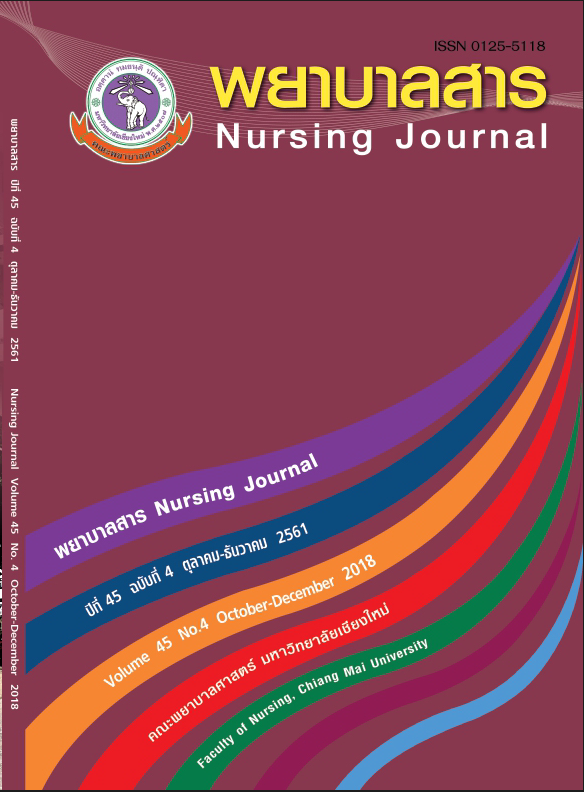Development of “DeeTorJai” Model for Chest Compression Training among Nursing Students
Keywords:
development of innovation, model for chest compression trainingAbstract
Chest compression is an important professional skill for nursing students. The purpose of this study aimed to develop the “DeeTorJai” prototype model for chest compression training and to study the satisfaction of nursing students toward the use of this innovation. The study was divided into two phases. The first phase was the process of developing the chest compression training prototype model for the 2015 American Heart Association (AHA) Guidelines Update for Cardiopulmonary Resuscitation (CPR) and Emergency Cardiovascular Care (ECC) in six steps: 1) assessing the experiences and needs assessment of using the chest compression training assisted model of nursing students; 2) reviewing the literature r and experts’ opinions 3) creating the “DeeTorJai” model; 4) inspecting the model by experts; 5) trying out the model; and 6) improving the model. The second phase was studying the satisfaction of nursing students towards the innovation. The samples included 30 third year nursing students.
Results:
The results of this study revealed that of the “DeeTorJai” prototype model for training chest compression was made from fabrics, coated rubbers, wires inside, and weight-bearing electronic circuits which were connected to a monitor. After implementation, it was found that scores of the satisfaction of most nursing students toward the innovation were at a high level as well as at the highest level.
Conclusions and suggestions:
The results of this study demonstrated that the “DeeTorJai” model is a useful innovation for training chest compression. Moreover, if it is improved, it can be developed to be a commercial innovation.
References
Improve Second-Year Nursing Students’ Skill in Performing Wound Swab Culture. Thai
Journal of Nursing Council, 31(1). 32-43. (in Thai)
Daungrat, B., Yantarapakon, A., Jirasinthipok, T., Sayorwan, W., Ratanawiboolsook, N., &
Saleepang, N. (2009). Development of Latex Arm Model for Suturing Practice. Journal of
Public Health and Development, 7(1), 47-60. (in Thai)
Kumkwan, Y., & Chaiyawut, P. (2014). The Development of Endotracheal-tube and
Tracheostomy-tube Suction Models for Suction Skill Practice. Journal of Phrapokklao
Nursing College, 25(2), 52-64. (in Thai)
Choeychom, S., & Rujiwatthanakorn, D. (2015).The Use of an Innovative Arm Mode in Practicing
an Intravenous Infusion Procedure of Nursing Students. Ramathibodi Nursing Journal,
21(3), 395-407. (in Thai)
Partiprajak, S. (2015). Relationship between Knowledge, Perceived Self-efficacy in Basic Life
Support (BLS) and Chest Compression Performance among Undergraduate
Nursing Students. Songklanagarind Journal of Nursing, 35(1). 119-132. (in Thai)
American Heart Association. (2015). Highlights of the 2015 American Heart Association
Guidelines Update for CPR and ECC. Retrieved June, 2016 from
https://eccguidelines.heart.org /wp-content/uploads/2015/10/2015-AHA-Guidelines-
Highlights-English.pdf.
Yimyam, S. (2016). Developing Stimulation Model for Training Clinical Skill of Health Science
Students. Nursing Journal , 43(2), 142-151. (in Thai)
Hertzog, M. A. (2008). Considerations in determining sample size for pilot studies. Research in
Nursing and Health, 31(2), 180-191.
Downloads
Published
How to Cite
Issue
Section
License
บทความที่ได้รับการตีพิมพ์เป็นลิขสิทธิ์ของวารสารพยาบาลสาร
ข้อความที่ปรากฏในบทความแต่ละเรื่องในวารสารวิชาการเล่มนี้เป็นความคิดเห็นส่วนตัวของผู้เขียนแต่ละท่านไม่เกี่ยวข้องกับมหาวิทยาลัยเชียงใหม่ และคณาจารย์ท่านอื่นๆในมหาวิทยาลัยฯ แต่อย่างใด ความรับผิดชอบองค์ประกอบทั้งหมดของบทความแต่ละเรื่องเป็นของผู้เขียนแต่ละท่าน หากมีความผิดพลาดใด ๆ ผู้เขียนแต่ละท่านจะรับผิดชอบบทความของตนเองแต่ผู้เดียว





